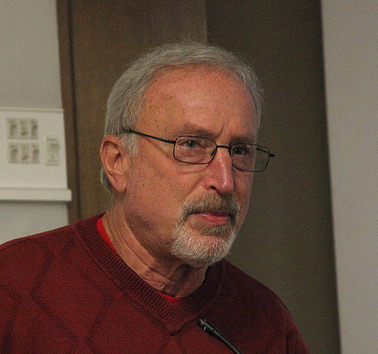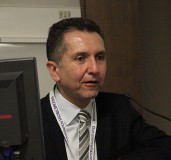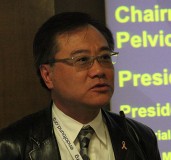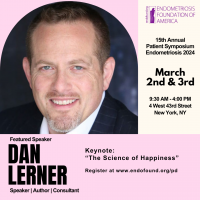Endometriosis Foundation of America
Endometriosis 2013 / Video Lectures & Presentations
- Harry Reich, MD
...put on some traction...and then using a CO2 laser I went in ever increasing circles, around and around and around until the nodule that was buried in the rectum could come out of the rectum, could be excised out of the rectum, without entering the rectum. Yes, this is time consuming but you can see with the laser you have your visual end points you see white fibrosis and you see the normal looking tissue around it. Stay at the junction. As we stay at the junction in this kind of case we can slowly but surely take away all that - it is almost like a flower going the opposite way, blooming, so the endometriosis you end up you have to undo the petals of the flower and find the lesion in the middle, which is a deep fibrotic endometriosis - did not invade the rectum. It was there so I think we have to push that point more.
When we think of endometriosis in surgery we think of a condition that should be curable. Sometimes that means extra training in surgical excision techniques but as you can see we get rid of the laser and you can see the nodule that was inside the rectum. As you will see also, it is very close to the rectal mucosa. You will be able to see the rectal mucosa at the end. We take the deep fibrotic nodule out in two pieces. Here I am tenting up the rectum mucosa and cutting right on probably the sub-mucosal rectum at the junction of fibrosis with rectal sub-mucosal to remove the nodule. I just think it is important because so many other different techniques will leave all this stuff behind or resect it in total by taking a lot of normal tissue with it. You can see the rectum, very thin, probably filled with fluid at this point, which is a much better test than filling the rectum with gas. Everybody tells you to fill it with gas at the end of the operation, with air, whatever, and check for perforations, but here we fill it with blue fluid if we did not see any - let me show you what we are talking about when we say the blue fluid tests.
Another quick example before we - okay, here is another case with extensive rectal endometriosis, this is a redo. This patient still had some endometriosis after a large nodule had been removed. We start these operations, I progress with scissors. I will tolerate a little bit of bleeding but I do not want to burn around the rectum. I do not want to use thermal energy sources. I enjoy the term vessel sealing devices that Roseanne said today...which I presume is either bipolar or harmonic. There is a big difference you know between bipolar and harmonic. For you who use harmonic realize the temperature that will be generated is over double the temperature generated by bipolar forceps. Bipolar is 100° centigrade, harmonic is well over 200° centigrade. They do not tell you that. Quickly, I am sorry I missed my point, we are just going to go backwards here.
This was a relatively extensive case where we had to first separate the rectum from the back of the uterus and all the way down. I am going to go faster to get to the interesting part. If you look at the screen you are not going to see too much right now because it is going too fast but you can see there is a lot of rectum endometriosis but not deep, it is not like the nodule I showed you in the first picture. We take it off in sheets of tissue and at the end of the operation I put a clamp across the sigmoid. I fill the rectum and sigmoid up with blue dye, first gas and there are no leaks. We are home free. Now you can see removing some of the lesion, here is the clamp going across and quickly look at what we see we will fill it up with blue dye. I see not one thin area, I see about ten thinned out areas. I am looking at rectal mucosa and your gas test is going to be negative. You are not going to get any air underwater, any bubbles.
This is rectum that has a high probability of blowing out I would think. I could show you a blow out in case two but we do not have time to do that. Anyway, this has a high chance so I decided to resect it. The way I do it I insert a circular stapler inside the rectum, I open it up, I invaginate the lesion into the circular stapler. You can see the outline of the circular stapler as it comes in - this is just a cyst...just to check the bladder at the same time. One can see the suture coming in. Just a suture I did not tie any knots or anything. I used a suture to guide the thinned out areas of rectum into the jaws of the circular stapler. The circular stapler is in place. It is then opened and one will see the lesion get invaginated. I check out the thinned out areas to make sure they are all included in the jaws of the stapler. I stress this technique. I have been stressing this technique since the early 1990s. It works. I have never had a late complication or a leak from using this kind of technique. What we really take is a discoid anterior section of rectum, you could take more. Notice how the rectum, as you open the circular stapler, falls into that place. Then my assistant holds the handles way down to the floor so that the action part of the instrument is high in the air so it can repel together again. Here it comes together again, a very nice technique, very useful. It is also very useful if you have a definitive hole in the rectum that you see during your surgery. You can invaginate the hole into the jaws of the circular stapler, it is pretty safe.
Okay, from what I can understand so far yesterday was a very stimulating meeting with many of the patients. Tomorrow we are going to hear many, many, many ten to 15 minute talks on all kinds of things involving endometriosis and we all have many areas of disagreement and some of agreement. But again, I think the basis for Tamer's meeting is to encourage the surgical excision of endometriosis in the least traumatic fashion with the least amount of tissue destruction.
I look forward to greeting you all in the lab this afternoon. Thank you.










